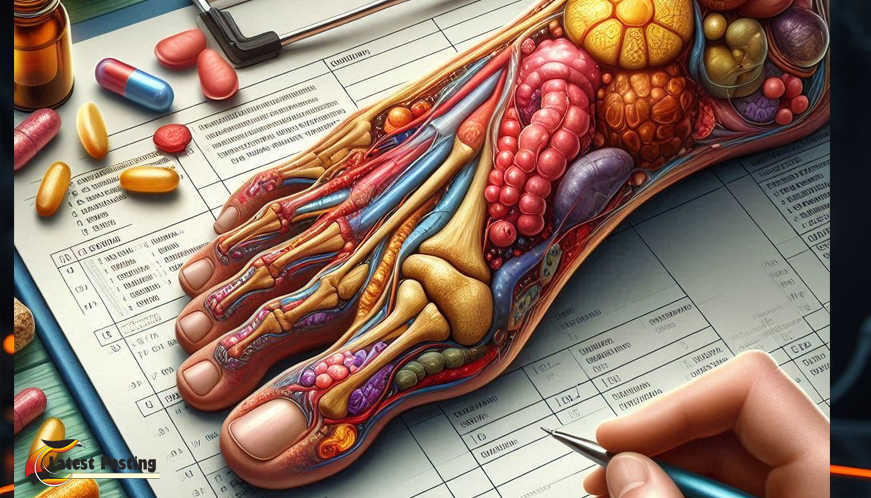Gout is a painful form of inflammatory arthritis caused by high levels of uric acid in the blood, leading to crystal deposits in joints. For healthcare professionals, accurate diagnosis and coding are crucial—not just for treatment but also for insurance and billing purposes. That’s where Gout ICD 10 comes in.
The ICD-10 (International Classification of Diseases, 10th Revision) code for gout ensures proper documentation, seamless claims processing, and effective patient care. Whether you’re a medical coder, physician, or patient, understanding Gout ICD 10 codes can help streamline healthcare management.
In this guide, we’ll break down:
- The ICD-10 codes and related conditions
- Symptoms, causes, and risk factors
- Diagnosis and treatment options
- Billing and coding best practices
- FAQs and actionable tips
Understanding it: Symptoms and Causes
What Is Gout?
It is a type of arthritis that causes sudden, severe pain, redness, and swelling—often in the big toe. It occurs when urate crystals accumulate in the joints due to high uric acid levels (hyperuricemia).
Common Symptoms
- Intense joint pain (usually starts at night)
- Swelling and redness around the affected joint
- Limited mobility due to stiffness
- Recurrent flare-ups if left untreated
The Causes
Several factors contribute it, including:
Diet (high-purine foods like red meat, seafood, alcohol)
Obesity
Genetics (family history of gout)
Medical conditions (hypertension, diabetes, kidney disease)
Medications (diuretics, immunosuppressants)
Gout ICD 10 Codes: The Complete Breakdown
Accurate coding is essential for diagnosis, treatment, and insurance reimbursement. Below are the primary ICD-10 codes for this:
Primary Gout ICD 10 Codes
| ICD-10 Code | Description |
|---|---|
| M10.9 | Gout, unspecified |
| M10.0 | Idiopathic gout |
| M10.1 | Lead-induced gout |
| M10.2 | Drug-induced gout |
| M10.3 | Gout due to renal impairment |
| M10.4 | Other secondary gout |
| M10.9 | Gout, unspecified |
Gout by Affected Site
| ICD-10 Code | Description |
|---|---|
| M10.071 | Gout, right ankle |
| M10.072 | Gout, left ankle |
| M10.9 | Gout, unspecified |
Chronic Gout ICD 10 Codes
Chronic gout leads to tophi (uric acid lumps under the skin). Key codes include:
- M1A.9 – Chronic gout, unspecified
- M1A.0 – Idiopathic chronic gout
Diagnosing Gout: Tests and Procedures
Doctors use several methods to confirm it:
1. Joint Fluid Test (Arthrocentesis)
- A needle extracts fluid from the swollen joint.
- Lab analysis checks for urate crystals.
2. Blood Uric Acid Test
- High uric acid levels (>6.8 mg/dL) suggest it.
3. Imaging Tests
- X-rays – Detects joint damage in chronic cases.
- Ultrasound – Identifies urate crystals.
- Dual-energy CT scan – Visualizes crystal deposits.
Effective Treatment Options for Gout
Medications for Acute Gout Attacks
- NSAIDs (Ibuprofen, Naproxen) – Reduce pain and inflammation.
- Colchicine – Blocks uric acid crystal effects.
- Corticosteroids (Prednisone) – For severe swelling.
Long-Term Gout Management
- Uric Acid-Lowering Drugs (Allopurinol, Febuxostat)
- Dietary Changes – Low-purine foods, hydration, limit alcohol.
- Lifestyle Adjustments – Weight management, exercise.
Gout ICD 10 Coding Best Practices
Medical coders must ensure accuracy to avoid claim denials. Follow these tips:
Specify the type of this (idiopathic, secondary, chronic).
Include the affected joint (e.g., M10.071 for right ankle gout).
Document comorbidities (e.g., kidney disease).
Example of Proper Coding:
- Diagnosis: “Acute gout flare in the left big toe due to hyperuricemia.”
- ICD-10 Code: M10.072 (Gout, left ankle) + E79.0 (Hyperuricemia).
FAQs About Gout ICD 10 Codes
1. What is the most common ICD-10 code for gout?
- M10.9 (unspecified) is frequently used when details are lacking.
2. How do you code chronic gout with tophi?
- Use M1A.9 (Chronic , unspecified) or specify the site (e.g., M1A.071 for right ankle).
3. Can gout be mistaken for other conditions?
- Yes! Pseudogout (calcium crystal arthritis) has similar symptoms but uses ICD-10 M11.9.
4. What foods trigger gout flare-ups?
- Red meat, shellfish, alcohol (especially beer), and sugary drinks.
Conclusion: Managing Gout with Proper ICD-10 Coding
Understanding ICD 10 codes ensures accurate diagnosis, treatment, and billing. Whether you’re a healthcare provider or coder, using the right codes improves patient outcomes and reduces claim rejections.
Need help with medical coding? Bookmark this guide or consult an expert to stay updated on the latest ICD-10 changes.
📢 Have questions about ICD-10 coding? Drop a comment below!
Infographic: Gout ICD 10 Quick Reference Guide
By following this guide, you’ll master ICD 10 coding and improve patient care. Stay informed, code accurately, and keep those claims flowing smoothly! 🚀





One thought on “Gout ICD 10: A Comprehensive Guide to Diagnosis, Coding, and Treatment”